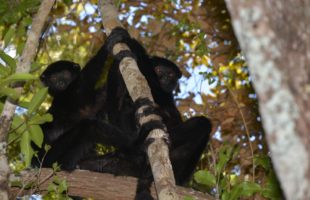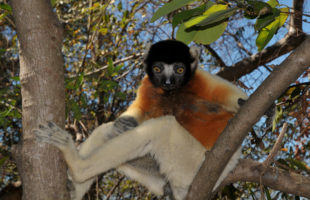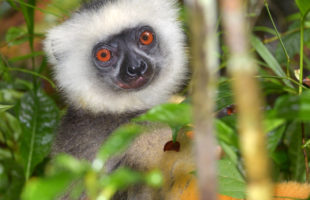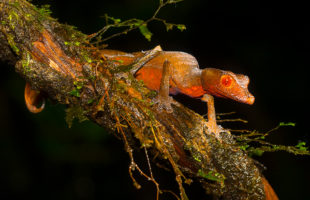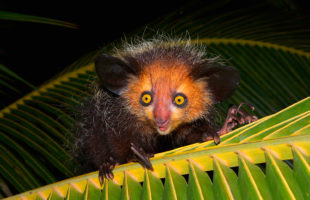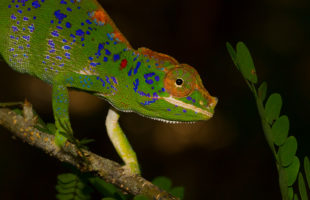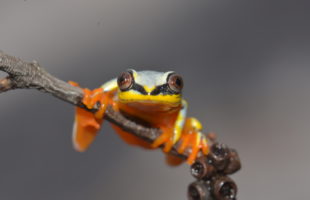As early as 1802, French colonialists in Madagascar discovered a unique, white-flowering orchid whose waxy blossom had a diameter of a good 12 cm. They had never seen anything like it, and so it was also a Frenchman named Du Petit-Thouars, who 20 years later wrote down a description of the peculiar flower for the first time. He called it …
LesenThe rarest lemur on Earth: Perrier’s Sifaka
Practically the counterpart to the white Silky Sifaka is the closely related Black Sifaka or Perrier’s Sifaka (Propithecus perrieri). With a height of 85 to 92 cm and a weight of three to six kilograms, it belongs to the larger lemurs, with the tail accounting for up to 46 cm of its total length. Suitably to the name these animals …
LesenSecret kings of the North: Golden crowned sifakas
In an incredibly hot, dry and inaccessible area in north-eastern Madagascar live white lemurs, which owe their name to the golden fur on their heads: the Golden Crowned Sifakas (Propithecus tattersalli). The secret kings of the north reach a height of just 95 cm with a weight of 3.5 kg, whereby still further 45 cm of tail come in addition. …
LesenWidely spread, hardly researched: Crowned Sifakas
In the northwest of Madagascar live lemurs, which occur quite frequently, but are nevertheless hardly researched: The Crowned Sifakas (Propithecus coronatus). Their habitat is limited by the two rivers Mahavavy in the southwest and Betsiboka in the northeast. Today, however, there are indications that the species is much more widespread and also populates areas around Tsiroanomandidy, Amboloando (south of Miandrivazo) …
LesenNo life without the Ocotillo: Verreaux’ Sifakas
The Verreaux’ Sifakas (Propithecus verreauxi) lives in the south of Madagascar and belongs to the few lemurs that successfully colonize the hot and hostile spiny forests. It is a very adaptable species that can survive even in very small forest areas. It can even be found in some lowland rainforests in the southeast of the eighth continent. In the northwest, the …
LesenA diadem of fur: Diademed Sifakas
The Diademed Sifaka (Propithecus diadema) is with a total length of 105 cm and a weight between five and seven kilograms one of the largest lemurs of Madagascar and because of its unusual fur colors also one of the most beautiful. His face is framed by long white fur, which looks a bit like a tiara and gave these lemurs …
LesenThe Satanic Leaf-Tailed Gecko
A small but very pretty gecko lives well camouflaged in the rainforests of the central east and southeast in the highlands of Madagascar: the Satanic Leaf-Tailed Gecko (Uroplatus phantasticus). The little guy got his name from biologist George Boulenger as early as 1888. The Belgian first described the species and chose the name because of the bizarre appearance of the …
LesenLemurs, the spirits of the forest
Lemurs are probably Madagascar’s most famous mammals – not for nothing because they originally exist only there and nowhere else in the world. They belong to the strepsirrhine primates and are divided into about 100 different species. The word lemures comes from Latin and refers to the spirits of the dead of ancient Rome, who have little resemblance to the …
LesenReptiles in general
Madagascar is the reptile paradise per se and especially known for its chameleons. 92 of all 213 up to date described chameleon species only occur in Madagascar. They seem to be fabulous creatures with their strange tongue, the independently from eacht other movable eyes and feet and hands transformed into grapsing forceps. Unfortunately, those beautiful animals aren’t very popular with …
LesenAmphibians in general
Especially the rainforests of Madagascar offer an abundance of different frogs for observation and discovery. Almost 4% of the world’s amphibian fauna is found on the island. Especially in the rainy areas on the east coast, you can find countless different species in a small area. In the rainy season, the croaking, chirping, and chirping of the courtship males can …
Lesen MADAMAGAZINE Your Magazine about Madagascar
MADAMAGAZINE Your Magazine about Madagascar


